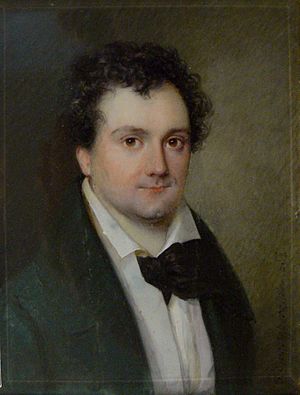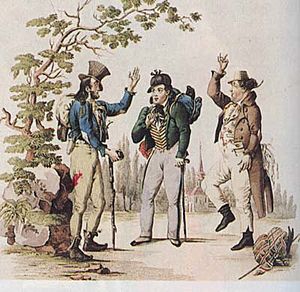Johann Nestroy facts for kids
Johann Nepomuk Eduard Ambrosius Nestroy (German: [ˈnɛstrɔɪ̯]; born December 7, 1801 – died May 25, 1862) was a famous Austrian singer, actor, and writer of plays. He lived during a time called the Biedermeier period in Austria. Nestroy was also part of the 1848 revolutions, which were big changes happening across Europe. His plays often showed the new ideas of freedom that were spreading.
Contents
Nestroy's Early Life and Career
Johann Nestroy was born in Vienna, Austria. He studied law from 1817 to 1822. But he loved music and acting more! So, he stopped studying law to become a singer.
He joined the Theater am Kärntnertor in Vienna. His first show was on August 24, 1822, where he sang the role of Sarastro in The Magic Flute. After singing in Vienna for a year, he moved to Amsterdam. There, he performed as a baritone singer for two years at the local German Theatre.
From 1825 to 1831, Nestroy performed in many cities. These included Brünn, Graz, Pressburg, Klagenfurt, Vienna, and Lemberg. After this, he returned to his home city of Vienna. This is when he started to write plays, while still performing on stage.
Becoming a Famous Playwright
Nestroy quickly became a successful playwright. His play Der böse Geist Lumpazivagabundus in 1833 was a huge hit! He soon became a very important person in Austrian culture and society.
Nestroy took over from another famous actor-writer, Ferdinand Raimund. Nestroy became the main actor and writer at the Volkstheater. This was a popular theater in Vienna, often called the 'people's theatre'.
Nestroy's Unique Style of Comedy
While Raimund focused on romantic and magical stories, Nestroy used comedy differently. He used it for parody (making fun of something) and criticism. He worked during the time of a strict minister named Klemens von Metternich. This meant Nestroy had to be very careful with his plays. He had to write them in a way that avoided the strict censorship rules.
Nestroy was famous for his clever wordplay. His characters often mixed the local Viennese German language with attempts at more "educated" speech, which sometimes went wrong in funny ways. Music was also very important in his plays. Songs often helped explain the story or move the plot along.
Nestroy wrote almost eighty comedies between the 1830s and the 1850s. Some of his most important plays include:
- Der böse Geist Lumpacivagabundus
- Liebesgeschichten und Heurathssachen
- Der Talisman (which later became a musical comedy)
- Einen Jux will er sich machen (translated as On the Razzle by Tom Stoppard)
- Der Zerrissene
All these plays were known for their social criticism and sharp humor. Johann Nestroy passed away in Graz, Austria.
Nestroy's Works and Music
Nestroy remained a singer throughout his life. Because of this, almost all of his plays included music. He worked closely with a few composers. Adolf Müller senior wrote music for 41 of Nestroy's plays between 1832 and 1847. Michael Hebenstreit set music for 10 works from 1843 to 1850. Carl Binder composed music for seven plays from 1851 to 1859. Other composers he worked with included Anton M. Storch, Franz Roser, Carl Franz Stenzel, and Andreas Skutta.
Most of Nestroy's works were called a type of Posse, which means a farce or funny play. Many of these were Possen mit Gesang, meaning they included singing. He also wrote many parodies. These were funny imitations of operas and dramas. For example, he parodied famous operas like The Magic Flute, Lohengrin, and Martha.
His early plays were performed in Graz and Pressburg. Then, from 1832 to 1846, he worked only at the Theater an der Wien. Forty-five of his plays were first shown there. After two plays at the Theater in der Leopoldstadt, he moved to the Carltheater. Another 20 of his plays were performed there from 1847 to 1859.
Nestroy's Lasting Legacy
About half of Nestroy's plays are still performed today in German-speaking theaters. Many of them are a regular part of the shows in Vienna. However, not many of his plays have been translated into English. Only one, Einen Jux will er sich machen, is well-known to English-speaking theater fans.
This play became a classic more than once!
- It was first adapted in 1938 by Thornton Wilder as The Merchant of Yonkers.
- Wilder rewrote it again in 1954 as The Matchmaker.
- That version later became the famous 1964 musical Hello, Dolly! and the 1969 movie of the same name.
- Nestroy's original play also became successful in 1981 as On the Razzle, translated by Stephen Plaice and adapted by Tom Stoppard.
Nestroy has a square named after him in Vienna, called Nestroyplatz. There is also a subway station, Nestroyplatz, on Line 1 of the Vienna U-Bahn. This station opened in 1979. When the Reichsbrücke bridge had to be rebuilt in 1976, the group that won the job was called Project Johann Nestroy. The new bridge's official name is probably Johann Nestroy Brücke, but people don't usually call it that.
One of the most important theater awards in German-speaking countries is named after Nestroy. The Nestroy Theatre Prize is given out every year for Austrian theater. It has categories like the Oscars! The award ceremony is held in Vienna and shown live on national television.
The Austrian artist Reinhard Trinkler also adapted Nestroy's play Der Talisman into a graphic novel with the same name.
See also
 In Spanish: Johann Nestroy para niños
In Spanish: Johann Nestroy para niños





